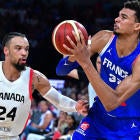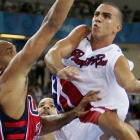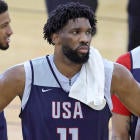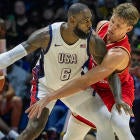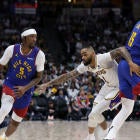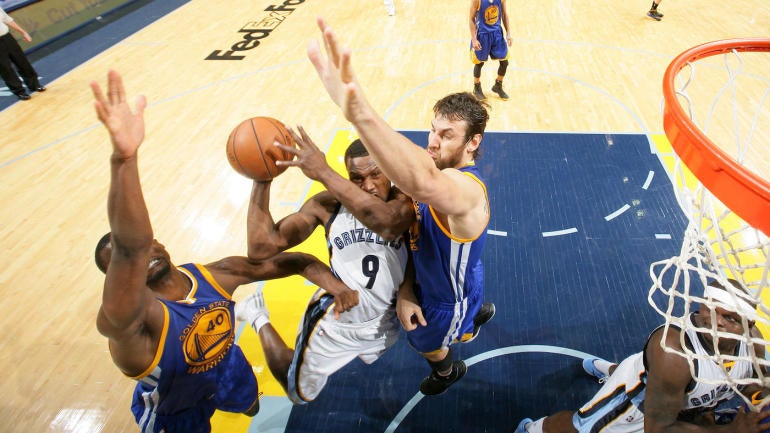
On May 11, 2015, the Golden State Warriors tried something different. Instead of matching up with Memphis Grizzlies center Marc Gasol, 7-footer Andrew Bogut sidled up to 6-foot-4 guard Tony Allen on their first defensive possession. Bogut only guarded Allen in the loosest sense of the word; when Allen caught the ball on the perimeter, no Warrior went near him.
The adjustment, made in Game 4 of the second-round series, caught Memphis off guard. Allen, who would soon be named to his fifth All-Defensive team, logged just 16 minutes after averaging 36 in the first three games. The Warriors won comfortably and went on to win the series, win the championship and become a dynasty. At the time, though, none of that felt inevitable. The grit-and-grind Grizzlies were roughing the Warriors up.
"What I remember about that series is that we were in trouble," Golden State assistant coach Ron Adams said.
Adams suggested the Bogut-on-Allen gambit to coach Steve Kerr on the plane to Memphis after Game 2, in which the Warriors' usually free-flowing offense was stuck in mud: Stephen Curry and Klay Thompson had shot a combined 3 for 17 from 3-point range in the 97-90 loss.
Down 2-1 after another grisly loss in Game 3, Kerr decided it was time for a change.
"This was a big moment for our program," Adams said. "This was the first year we had been with Golden State, Steve's first year of coaching. We knew our team by that time pretty well, but we didn't know our team in playoff basketball because we hadn't been there."
Kerr told a team that had won a league-best 67 games with best defense in the NBA that it was going to try something completely new. "You always worry a little bit when you have a great defensive team because we've done it a certain way and we've had great success, so why change?" Adams said. He does not, however, remember any pushback. "My impression was they thought it was a fairly workable idea."
Having a big guard a non-big was also a fairly radical idea, and, last month, Kerr told the San Francisco Chronicle that his instinctive response was, "Oh my god -- that's terrifying." Then he watched film and thought about how it would allow the Warriors to "skew the chess board," with Bogut able roam the paint, double-team Zach Randolph in the post and box out Marc Gasol.
"We had to utilize Bogut in a different way," Adams said. "Gasol would take you away from the basket. Zach Randolph, the same. They were versatile players, inside-outside players, so it strengthened our paint coverage defensively against a team that was very strong in that regard."
The strategy called for the Warriors to openly disrespect Allen's jumper, but, in a way, it was a sign of respect for the things he did well. "His strength was really mucking up a game," Adams said, describing him as a "catalyst for them" and "a pain for us."
Allen was one of the premier perimeter defenders in the NBA. He crashed the offensive glass with ferocity and was "a pretty excitable guy," Adams said, putting it mildly. Golden State forced Memphis to choose between benching its greatest source of energy and effectively playing every halfcourt possession 4-on-5.
"The emotional component of a team is very important, and when someone, maybe their role is changed a bit because of a move, whatever it might be, that can affect a team," Adams said. "And perhaps it affected them in that regard, too."
The Warriors defied convention on the recommendation of a then-67-year-old basketball lifer who describes himself as a "purist." Adams, now 75, said that the move represented a different way of looking at matchups but noted that an important figure in Warriors history had experimented with them.
"That was Don Nelson, who had terrifically strange matchups that one would think had no rhyme or reason but they worked, perhaps because of the psychology of the matchup," Adams said. "That kind of thing had certainly been done before. And so that's probably borrowing a small page from Don Nelson."
Nelson once had a rookie Dirk Nowitzki defend 5-3 guard Muggsy Bogues. The logic was that the 7-footer had enough length to double-team Bogues' teammates and recover to contest his shots. The difference between Nowitzki-on-Bogues and Bogut-on-Allen, though, is that the former did not almost immediately lead to copycats around the league. The Warriors' adjustment has made life harder on non-shooters, and, eight years later, no one blinked when the Denver Nuggets put Nikola Jokic on 6-4 Phoenix Suns guard Josh Okogie.
"Teams are much more willing to employ that kind of strategy now," Adams said. "By that I simply mean stranger matchups, not guarding certain people in an orthodox way. That's zoning up on them a little bit more. Protecting the basket. That kind of thing. I think it's pretty commonplace now."
The present-day Warriors used three different starting lineups in the first four games of their second-round series against the Los Angeles Lakers in an effort to make Anthony Davis leave the paint. On the other end, they've given Jarred Vanderbilt the Allen treatment, and his minutes have been cut from 26 in Game 1 to 11 in each of the last two games. And you can tell the story of the other ongoing series through the lens of players whom defenses ignore:
- In Game 5 against Denver, Okogie logged just eight minutes and Torrey Craig didn't play until garbage time because the Nuggets don't guard them. The Suns have turned to Terrence Ross, Landry Shamet and T.J. Warren for spacing, sacrificing some defense in the process.
- In Games 4 and 5 against the Boston Celtics, Sixers forward Jalen McDaniels didn't see the floor. Philadelphia coach Doc Rivers has changed his rotation to take away hiding spots for Robert Williams III, who transformed the Celtics' defense and his career last season when he essentially started playing the Bogut-on-Allen role full-time.
- In Game 5 against the Miami Heat, the New York Knicks played wing Quentin Grimes the full 48 minutes and cut Josh Hart's minutes to a measly nine. Their season was on the line, and Miami had been aggressively packing the paint all series long, daring Hart among other role players to shoot, just like New York had done to the Cleveland Cavaliers' supporting cast in the first round.
Leaving a player open on the perimeter does not come without risks. The Warriors know this better than anybody; for years, Draymond Green and Kevon Looney have taken advantage of the space in front of them to screen their shooters open. If the player in question is a particularly crafty passer, then the defense is giving him an opportunity to see the whole court and make any pass he wants, without being under duress. If he's particularly athletic, he could eat up the open space and put pressure on the rim.
Why, then, are teams seemingly content to accept these trade-offs whenever a non-shooter is stationed behind the 3-point line? Why has the definition of "non-shooter" expanded to include guys like Hart and P.J. Tucker, who have decent-to-good 3-point percentages but don't get 3s up frequently or quickly.
The short answer is that rim protection is extremely important and, when there's an opportunity to clog things up, defenses must take it. The longer answer is that the embrace of the 3-point shot changed the way NBA teams space the floor, so rim protection -- and defense in general -- is more difficult.
Which brings us back to the 2014-15 Warriors, who shot tons of 3s, switched on defense and inspired a league full of copycats. "That team in some ways was a trendsetter," Adams said. Since everybody wants to shoot like Golden State and specialists like Allen have largely disappeared, defenses need to find any little edge they can get.
"The 3-point shot has changed how you defend," Adams said. "And that's why teams are looking for a way to not guard one particular person, for example, and kind of gain an advantage of some sort."
The great irony of the Bogut-on-Allen adjustment is that it ran counter to Adams' philosophy. "Making every pass, shot or dribble difficult by pressuring the ball has always been No. 1 on my list," Adams said. He was willing to go "against the grain of how I think about defensive basketball," though, because the Warriors needed something to change the flow of the series and he thought this could do the trick.
Like all meaningful innovations, the adjustment that changed Golden State's series was designed to solve a specific problem. When you're coaching a team that's out of sorts in a series, you can't fool yourself about your roster's strengths and weaknesses, nor can you afford to be afraid of trying something different. "You're forced to think out of the box," Adams said, because that's the nature of playoff basketball. Sometimes, one tweak can make all the difference.
"So we tried it," he said. "It worked."










